
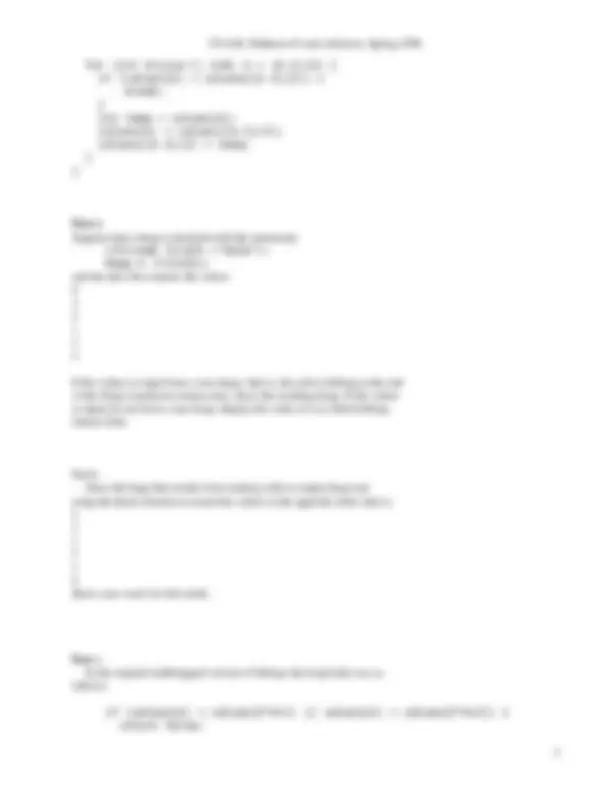
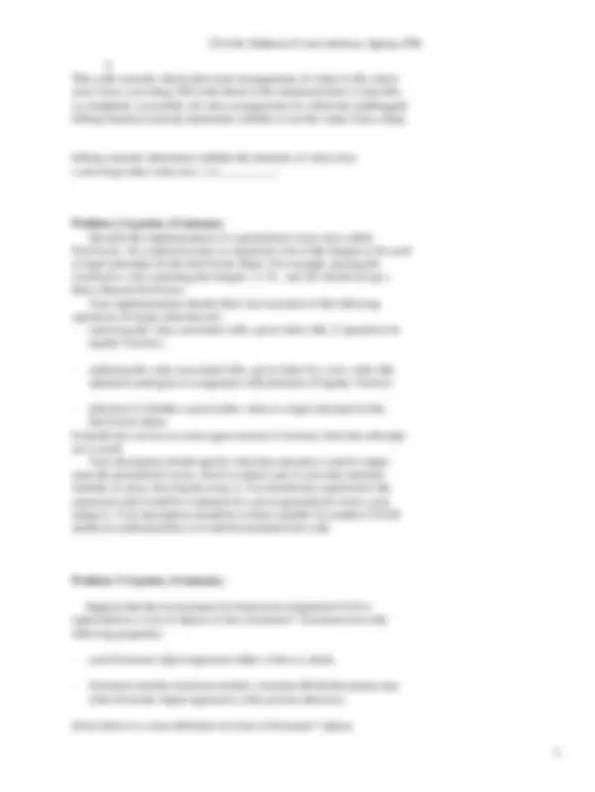
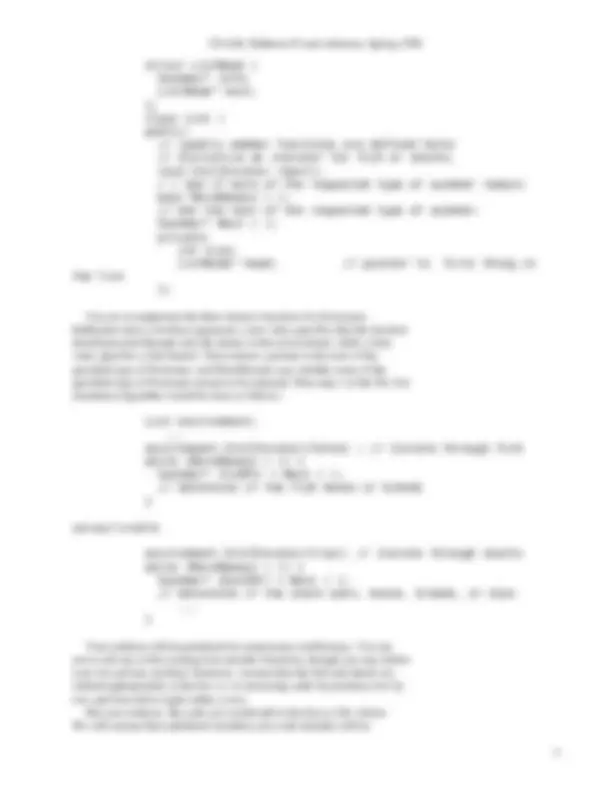
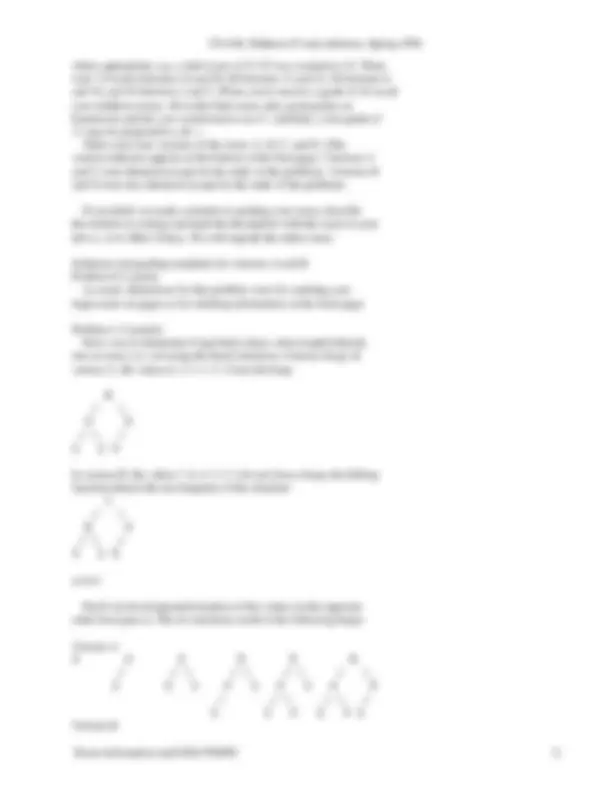
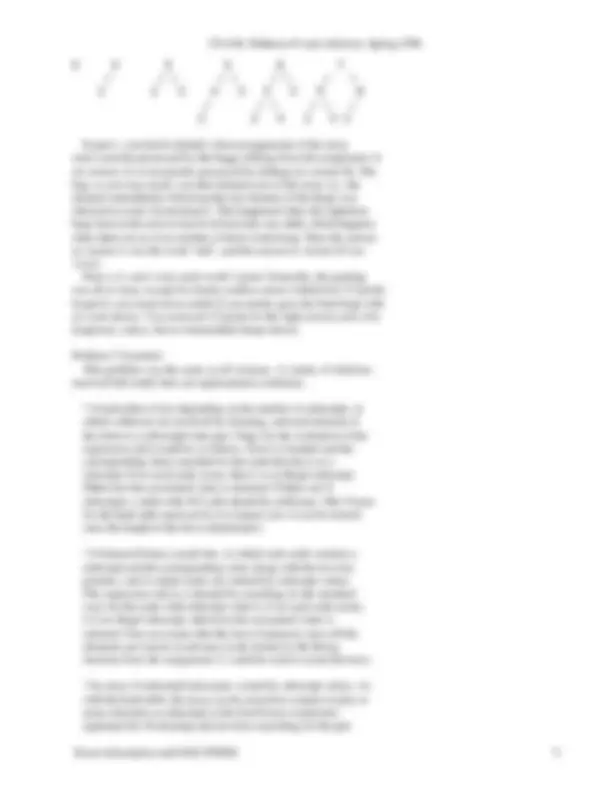
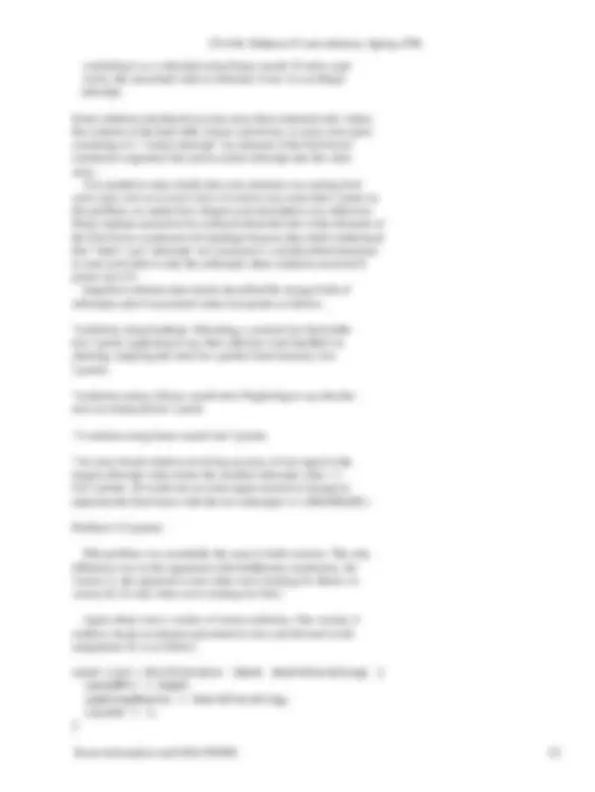
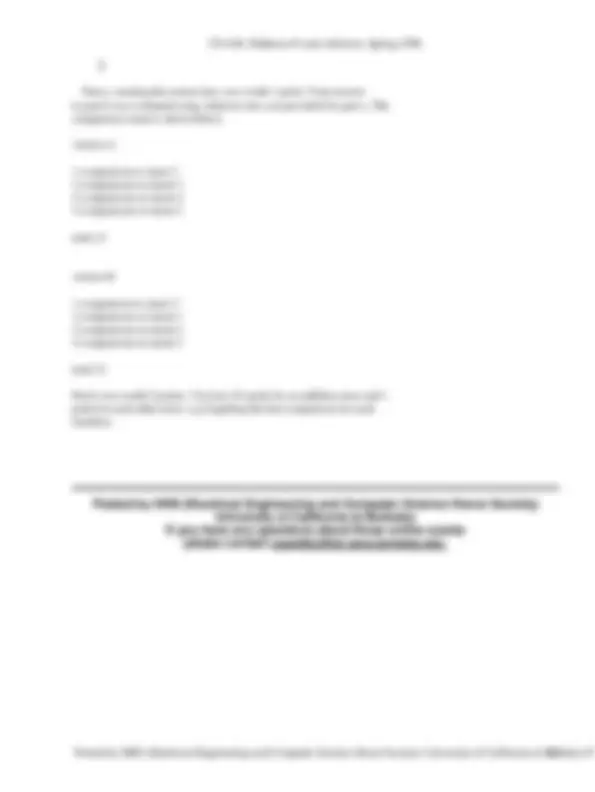


Study with the several resources on Docsity

Earn points by helping other students or get them with a premium plan


Prepare for your exams
Study with the several resources on Docsity

Earn points to download
Earn points by helping other students or get them with a premium plan
Community
Ask the community for help and clear up your study doubts
Discover the best universities in your country according to Docsity users
Free resources
Download our free guides on studying techniques, anxiety management strategies, and thesis advice from Docsity tutors
Main points of this exam paper are: Resulting Trees, Avoid Confusion, Information Requested, Debugged Version, Heap Verification, Opposite O, Full Credit, Undebugged Version, Element Genvector, Legal Subscript
Typology: Exams
1 / 13

This page cannot be seen from the preview
Don't miss anything!








CS61B (Clancy) Spring 1996 Exam 3, solutions, and grading standards.
April 12, 1996 Exam 3
Read and fill in this page now. Do NOT turn the page until you are told to do so.
Your name: Your login name: Your lab section day and time: Your lab t.a.: Name of the person sitting to your left: Name of the person sitting to your right:
Problem 0 __ Problem 1 __ __ __ Problem 2 __ Problem 3 __ Problem 4 __ Problem 5 __ __
Total: __/
This is an open-book test. You have approximately fifty minutes to complete it. You may consult any books, notes, or other paper-based inanimate objects available to you. To avoid confusion, read the problems carefully. If you find it hard to understand a problem, ask us to explain it. If you have a question during the test, please come to the front or the side of the room to ask it. This exam comprises 10% of the points on which your final grade will be based. Partial credit will be given for wrong answers. Your exam should contain six problems (numbered O through 5) on nine pages. Please write your answers in the spaces provided in the test. Anywhere you are directed to write a function, your solution may include auxiliary functions. You need not rewrite a function that appears in Deitel and Deitel, in Carrano, or in any of the CS 61B handouts; merely cite the page in the textbook or the handout in which the function appears. A few students are taking this exam next week. Do not discuss this exam with them, or post any news about the exam until next Wednesday. Relax--this exam is not worth having heart failure about.
Problem 0 (1 point, 1 minute) Put your login name on each page. Also make sure you have provided the information requested on the first page.
Problem 1 (3 points, 8 minutes) A debugged version of the code for heap verification and insertion used in lab assignment 11 appears below. Buestions in parts a and b refer to this code.
heaps.h
class Heap ( public: Heap (ifstream&); bool IsHeap (); void Insert (int); private: int size; Vector
heaps.cc
Heap::Heap (ifstream& valuesIn): size(0), values(some positive integer) { int value; while (valuesIn >> value) { values[size] = value; size++; }; assert (IsHeap ()); }
bool Heap::IsHeap () { for (int k=O; k<size/2; k++) { if (values[k] < values[2k+ll) { return false; } if (k < (size-1)/2 && values[k] < values[2k+21] { return false; } } return true; }
void Heap::Insert (int newValue) { values[size] = newValue; size++;
This code correctly checks that some arrangements of values in the values array form a max heap. Fill in the blank in the statement below to describe, as completely as possible, all value arrangements for which the undebugged IsHeap function correctly determines whether or not the values form a heap.
IsHeap correctly determines whether the elements of values fom a max heap when value.size ( ) is __________.
Problem 2 (6 points, 15 minutes) Describe the implementation of a generalized vector class called GenVector. Its constructor takes as argument a list of the integers to be used as legal subscripts for the GenVector object. For example, passing the constructor a list containing the integers -5, 42, and 363 should set up a three-element GenVector. Your implementation should allow fast execution of the following operations for large subscript sets:
Problem 3 (5 points, 14 minutes)
Suppose that the environment for homework assignment 9+10 is represented as a List of objects of class Swimmer*. Swimmers have the following properties:
Given below is a class definition for Lists of Swimmer* objects.
struct ListNode ( Swimmer* info; ListNode* next; }; class List ( public: // (public member functions are defined here) // Initialize an iterator for fish or sharks. void InitIterator (bool); / / See if more of the requested type of swimmer remain. bool MoreRemain ( ); // Get the next of the requested type of swimmer. Swimmer* Next ( ); private: int size; ListNode* head; // pointer to first thing in the list };
You are to implement the three iterator functions for Swimmers. InitIterator takes a boolean argument; a true value specifies that the iteration should proceed through only the sharks in the environment, while a false value specifies a fish iterator. Next returns a pointer to the next of the specified type of Swimmer, and MoreRemain says whether more of the specified type of Swimmer remain to be returned. Thus step 1 of the Wa-Tor simulation algorithm would be done as follows:
List environment; ... environment.InitIterator(false) ; // iterate through fish while (MoreRemain ( )) { Swimmer* fishPtr = Next ( ); // determine if the fish moves or breeds }
and step 2 would be
environment.InitIterator(true); // iterate through sharks while (MoreRemain ( )) { Swimmer* sharkPtr = Next ( ); // determine if the shark eats, moves, breeds, or dies ... }
Your solution will be penalized for unnecessary inefficiency. You are not to call any of the existing List member functions, though you may define your own private auxiliary functions. Assume that the fish and sharks are ordered appropriately in the list, i.e. in increasing order by position (row by row and from left to right within a row). Put your solution--the code you would add to the lists.cc file--below. We will assume that undefined variables your code includes will be
Problem 5 (3 points, 7 minutes)
Given below is an untemplated version of code from lab assignment 11 that implements a binarv search tree.
class BinSrchTree { public: BinSrchTree (); void Insert (ItemType);
private: TreeNode* tree; // 0 for an empty tree; points to the root of a nonempty tree TreeNode* InsertHelper (ItemType, TreeNode*); };
void BinSrchTree::Insert (ItemType x) { tree = InsertHelper (x, tree); } TreeNode* BinSrchTree::InsertHelper (ItemType x, TreeNode* treePtr) { if (treePtr == 0) { return new TreeNode (x); } else if (x <= treePtr->info) { treePtr->left = InsertHelper (x, treePtr->left); return treePtr; } else { treePtr->right = InsertHelper (x, treePtr->right); return treePtr; } }
Comparisons are highlighted in boldface.
Part a Draw the tree that results from inserting the values 1, 3, 4, 2 in sequence into an initially empty tree.
Part b How many total comparisons are made when inserting the values 1, 3, 4, 2 in sequence into an initially empty tree? Show your work for full credit.
Exam information and SOLUTIONS
225 students took the exam. Scores ranged from 1 to 20, with a median of 13 and an average of 12.8. Score totals were rounded up
Exam information and SOLUTIONS 7
where appropriate; e.g. a total score of 13 1/2 was counted as 14. There were 74 scores between 16 and 20, 80 between 11 and 15, 56 between 6 and 10, and 16 between 1 and 5. (Were you to receive a grade of 16 on all your midterm exams, 48 on the final exam, plus good grades on homework and lab, you would receive an A-; similarly, a test grade of 11 may be projected to a B-.) There were four versions of the exam, A, B, C, and D. (The version indicator appears at the bottom of the first page.) Versions A and C were identical except for the order of the problems. Versions B and D were also identical except for the order of the problems.
If you think we made a mistake in grading your exam, describe the mistake in writing and hand the description with the exam to your lab t.a. or to Mike Clancy. We will regrade the entire exam.
Solutions and grading standards for versions A and B Problem 0 (1 point) As usual, deductions for this problem were for omitting your login name on pages or for omitting information on the front page.
Problem 1 (3 points) Part a was to determine if specified values, when loaded directly into an array (i.e. not using the Insert function), formed a heap. In version A, the values 6, 3, 5, 1, 2, 4 form the heap
6 /
3 5 / \ / 1 2 4
In version B, the values 7, 6, 4, 3, 2, 5 do not form a heap; the IsHeap function detects the non-heapness of the structure 7 /
6 4 / \ / 3 2 5
at k=2.
Part b involved repeated insertion of the values (in the opposite order from part a). The six insertions result in the following heaps:
Version A 4 4 4 5 5 6 / / \ / \ / \ /
2 2 1 4 1 4 1 4 5 / / \ / \ / 2 2 3 2 3 1 Version B
Exam information and SOLUTIONS 8
containing k as a subscript using binary search. If such a pair exists, the associated value is returned; if not, k is an illegal subscript.
Some solutions introduced an extra array that contained only values; the contents of the hash table, binary search tree, or array were pairs consisting of a "virtual subscript" (an element of the GenVector constructor argument list) and an actual subscript into the value array. You needed to state clearly that your structure was storing both subscrtipts and associated values to receive any more than 1 point on this problem, no matter how elegant your description was otherwise. Many students seemed to be confused about the role of the elements of the GenVector constructor list (perhaps because they didn't understand that "index" and "subscript" are synonyms?), and described structures to store and retrieve only the subscripts; these solutions received O points out of 6. Imperfect solutions that clearly described the storage both of subscripts and of associated values lost points as follows.
*(solutions using hashing) Allocating a constant size hash table lost 1 point; neglecting to say that collisions were handled via chaining, implying the need for a perfect hash function, lost 2 points.
*(solutions using a binary search tree) Neglecting to say that the tree was balanced lost 1 point.
*A solution using linear search lost 3 points.
*An array-based solution involving an array of size equal to the largest subscript value minus the smallest subscript value + 1 lost 3 points. (It would use an extravagant amount of storage to represent the GenVector with the two subscripts +/-1,000,000,000.)
Problem 3 (5 points)
This problem was essentially the same in both versions. The only difference was in the argument to the InitIterator constructor. (In version A, the argument is true when we're looking for sharks; in version B, it's true when we're looking for fish.)
Again, there were a variety of correct solutions. One version A solution, based on iterators presented in class and devised in lab assignment 10, is as follows.
void List::InitIterator (bool sharkIterating) { savedPtr = head; seekingSharks = sharkIterating; Locate ( ); }
Exam information and SOLUTIONS 10
bool List::MoreRemain ( ) { return savedPtr != 0; }
Swimmer* List::Next ( ) { ListNode* temp = aavedPtr; Locate ( ); return temp->info; }
void List::Locate ( ) { if (seekingSharks) { while (aavedPtr != O && !savedPtr->info->IsFish ()) { savedPtr = savedPtr->next; } } else { while (savedPtr != O && savedPtr->info->IsFish ()) { savedPtr = savedPtr->next; } } }
The invariant relation between iterator function calls is that savedPtr points to the node corresponding to the next Swimmer* to return. The seekingSharks variable is not really necessary, since the Locate function need merely locate a Swimmer that's the same kind as the one that was most recently found.
Some students coded recursive equivalents (or nonequivalents) for the while loops. Another approach involved having InitIterator construct the list of fish or sharks to return, then coding MoreRemain and Next exactly as in lab assignment 10. A more complicated solution involved having MoreRemain do the locating. The invariant for this solution is that savedPtr points somewhere after the node most recently returned, but not necessarily at the next node to return; a call to MoreRemain or Next should advance it appropriately. Note that calls to MoreRemain and Next need not alternate, the way they do in the examples; one might know for other reasons that there are at least a certain number of elements in the list, and make that many calls to Next without any calls to MoreRemain.
Points were awarded as follows: 2 points for advancing savedPtr correctly; 1 point for each of the rest of InitIterator, MoreRemain, and Next. Common bugs were missing the first element of the list or forgetting to move to the first relevant list item in InitIterator, forgetting in Next to increment savedPtr before returning, checking beyond savedPtr in MoreRemain (thus coding "two more remain"), and starting over at the beginning of the list each time.
Problem 4 (2 points)
Exam information and SOLUTIONS 11
Part a, creating the correct tree, was worth 1 point. Your answer to part b was evaluated using whatever tree you provided for part a. The comparison count is shown below.
version A
1 comparison to insert 1 3 comparisons to insert 3 5 comparisons to insert 4 5 comparisons to insert 2
total 14
version B
1 comparison to insert 3 3 comparisons to insert 1 3 comparisons to insert 4 5 comparisons to insert 2
total 12
Part b was worth 2 points. You lost 1/2 point for an addition error and 1 point for each other error, e.g forgetting the last comparison for each insertion.
Posted by HKN (Electrical Engineering and Computer Science Honor Society) University of California at Berkeley If 13